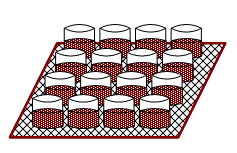You are here
Water-holding Capacity
Water-holding capacity is the amount of water that a soil horizon can store for plant use. It is estimated as the difference between lower limit of plant available water and the field capacity.
How to operationalize the metric
Method of data collection and data needed to compute the method:
Soil Water-Holding Capacity Determination
Reference:
Canadian Soil Methods book
Balance (capacity and precision)
Specimen cups – several small holes drilled in bottom perimeter
Milk filters, cut to fit inside bottom of specimen cups
Large plastic containers
Screen drain platforms
Small sample tins
Reagents:
Distilled water (DH2O)
Method:
- Allow soil samples to remain open to air until dry. Usually 72 to 120 hours depending on moisture content and container size.
- Air-dried soil should be coarsely sieved through 5 mm sieve. Discard materials remaining in sieve.
- Moisten milk filter with DH2O and place it over the bottom of the perforated specimen cup.
- Weigh the wet, empty specimen cup with filter and record the weight and cup number
- Weigh approximately 150g of sieved soil into the moistened cup and record the total weight.
- Simultaneously, weigh approximately 10-20 g of sieved soil into a numbered sample tin. Record the empty tin weight, the sample weight and tin number.
- Place these samples in a forced-air drying oven at 100 ºF for at least 12 hours.
- After a minimum of 12 hours, remove dried samples from the oven and weigh. Record dry weights of the tin + sample.
- When all specimen cups are filled and weighed, arrange them on screen drains inside the large plastic containers.
- Add DH2O to the bottom of the large container until the bottoms of all specimen cups are submerged by at least 1 cm. Leave the cups in the water until the soil on each top surface is moist and glistening.
- Remove the screen drain with sample cups to an air-tight container. Close tightly. Allow cups to drain for 48 hours.
- After 48 hours, open the air-tight container and remove excess water from the bottom of each sample cup with a sponge. Weigh each wet sample cup and record the weight.
- Calculate moisture content of the air-dried sample and the water-holding capacity for each sample.
Calculations:
Moisture Content of Air-dry Sample (%) =
Water-Holding Capacity (g H2O/g soil) =
Milk filters # D547 - Ken Ag Milk Filter Tube for pipeline systems (4-7/8” x 17”) 50 per box
American Livestock Inc. Madison, WI [www.americanlivestock.com]
Specimen cups #15310800 - 4 oz. plastic non-sterile polypropylene with screw cap
MSU University Stores
Unit of analysis:
Content here
Limitations regarding estimating and interpreting:
Content here



